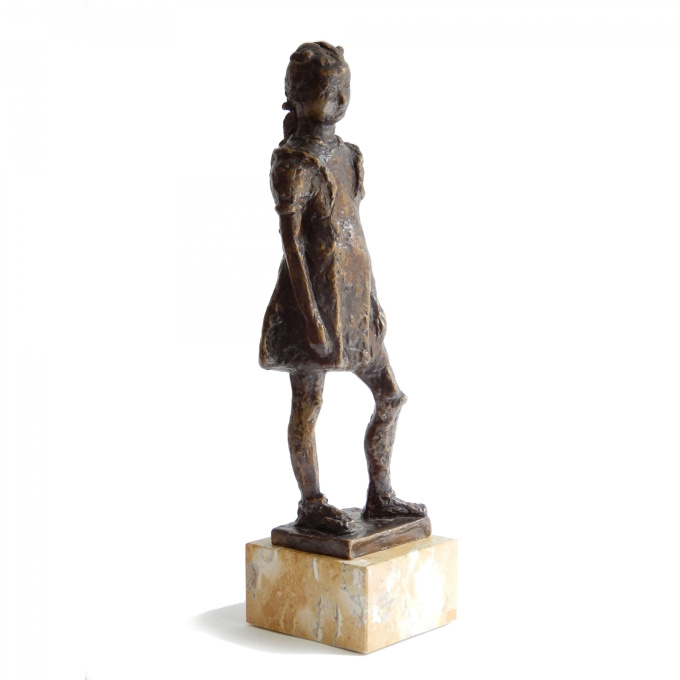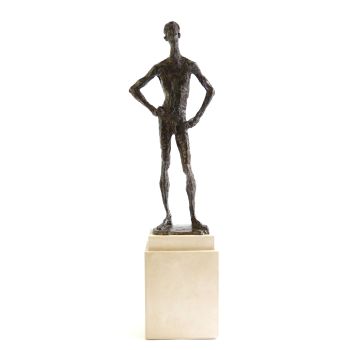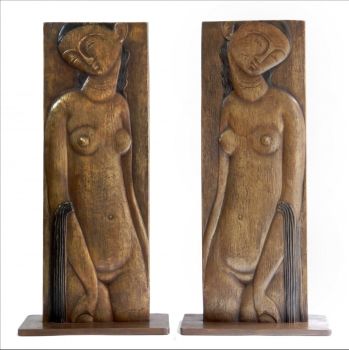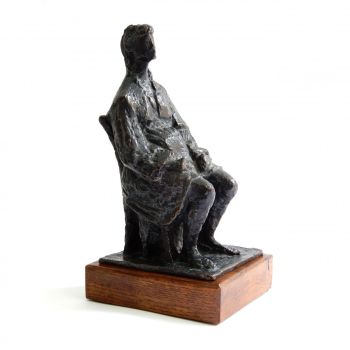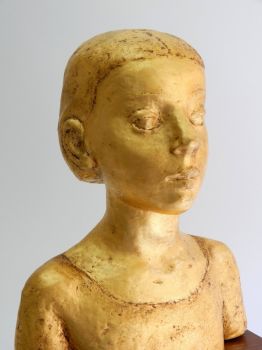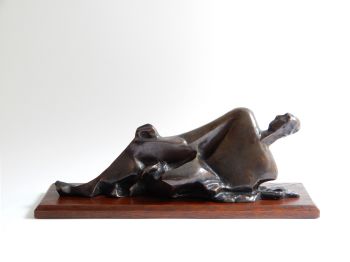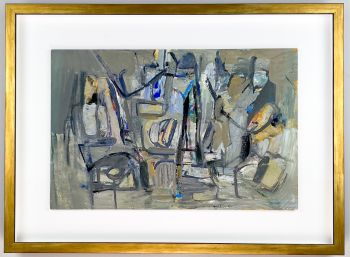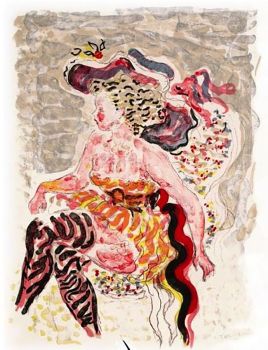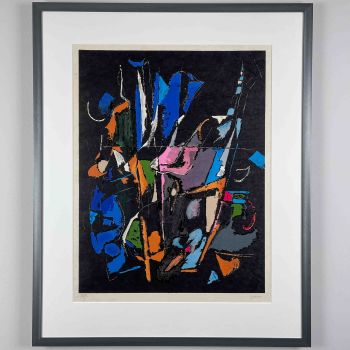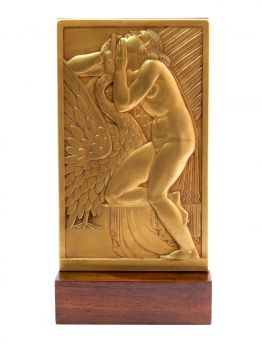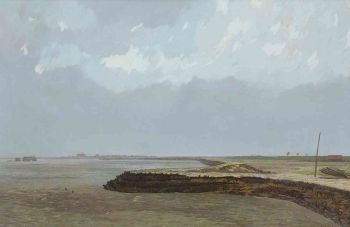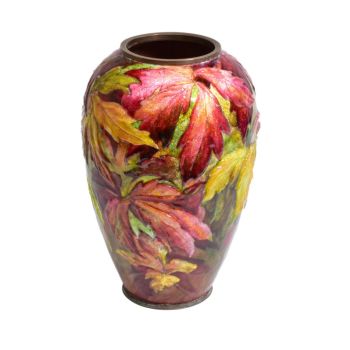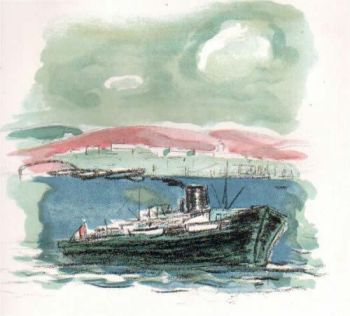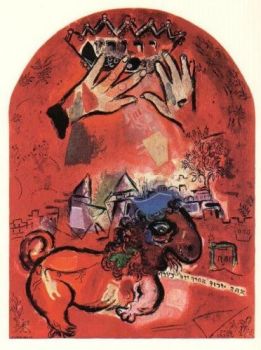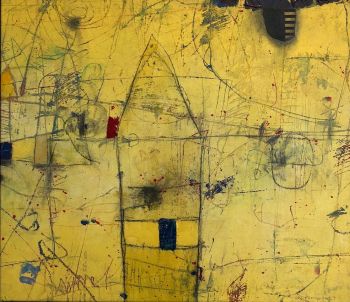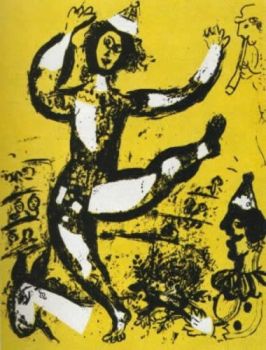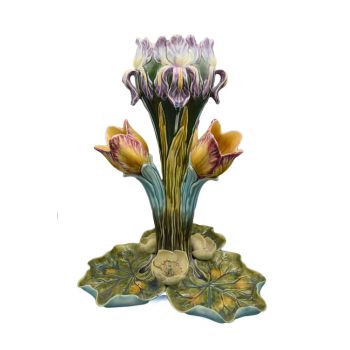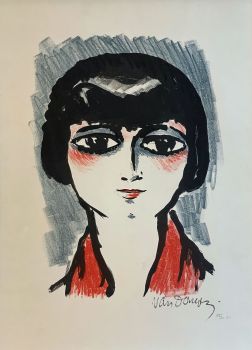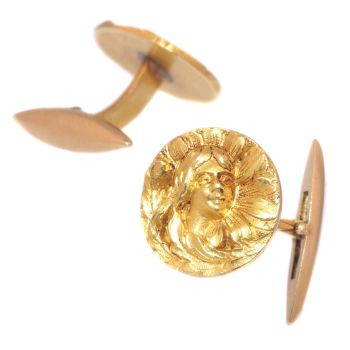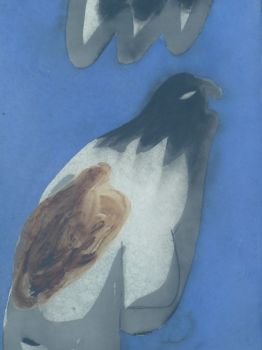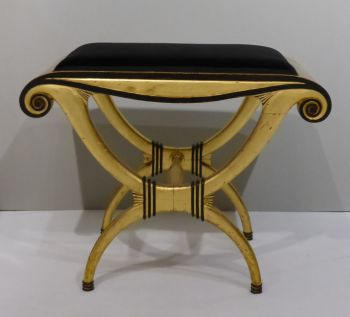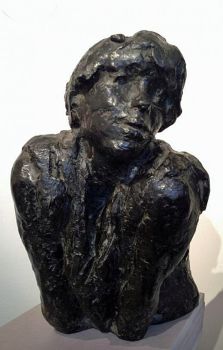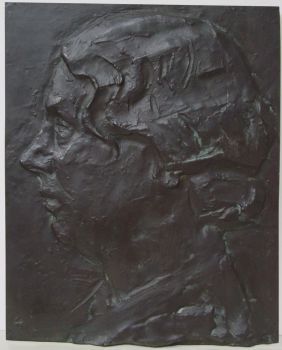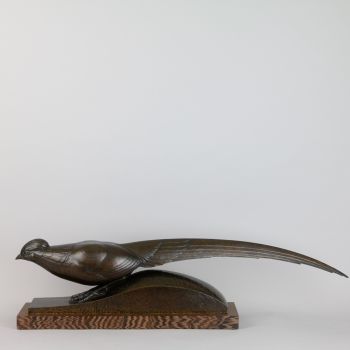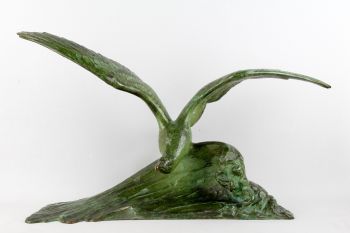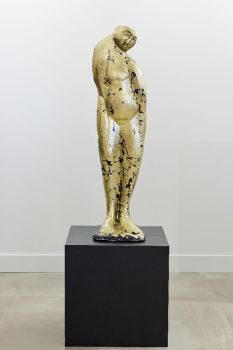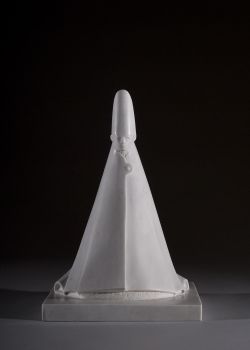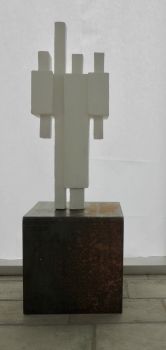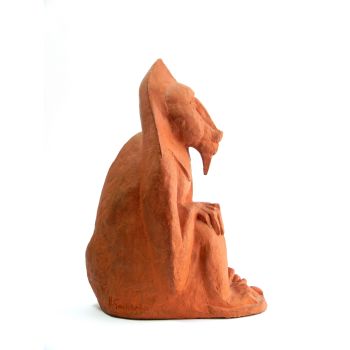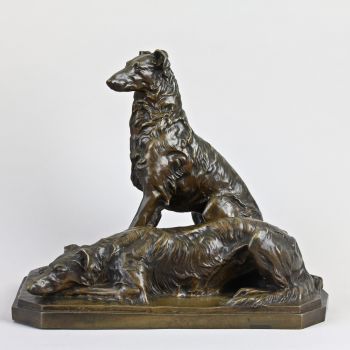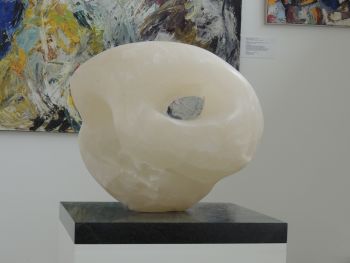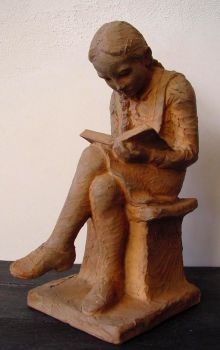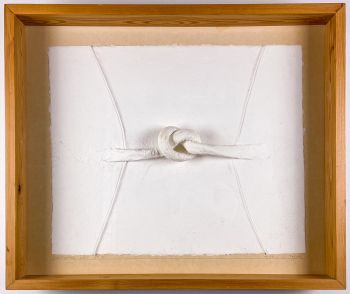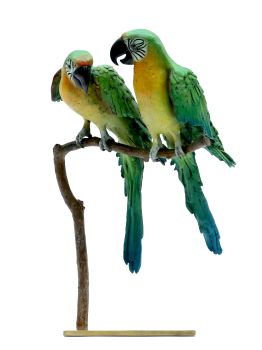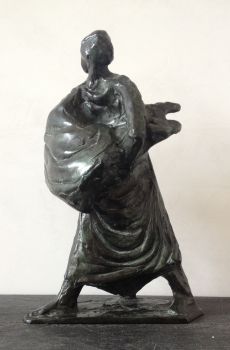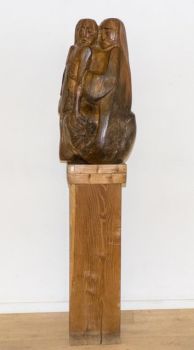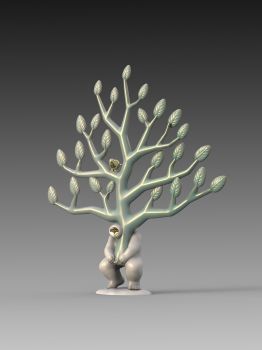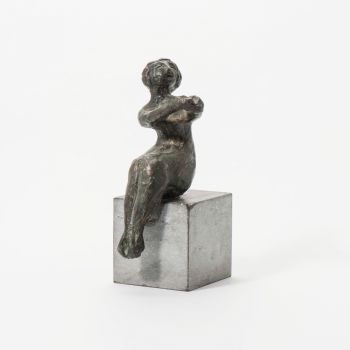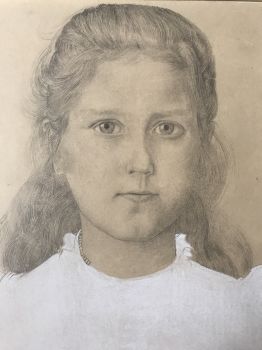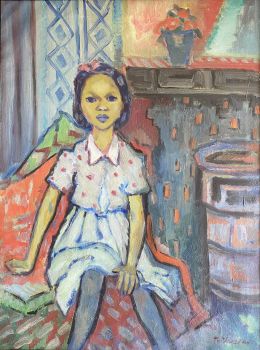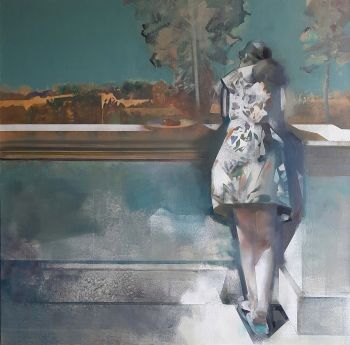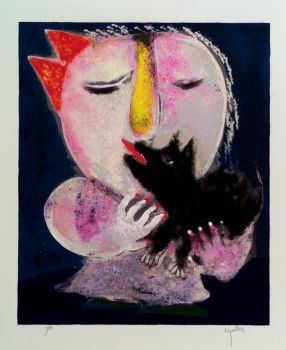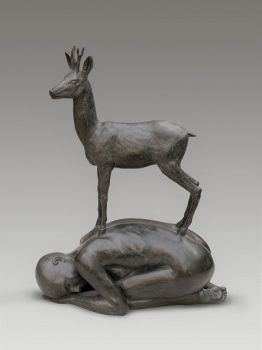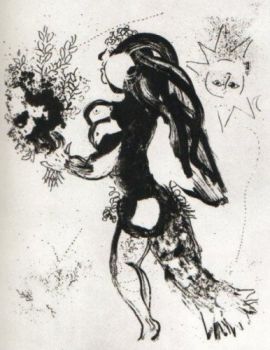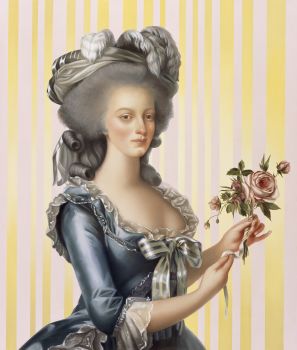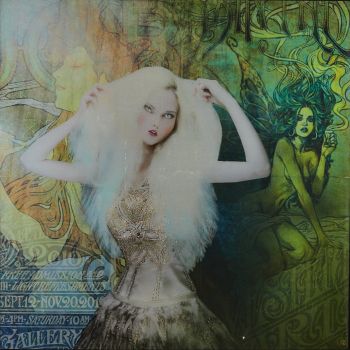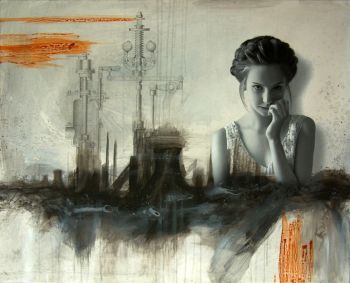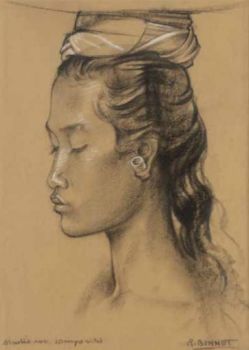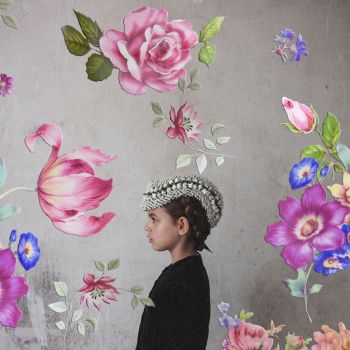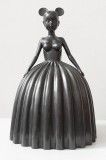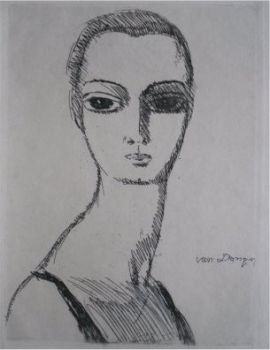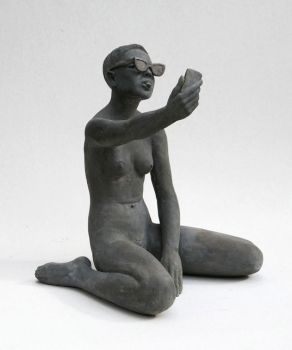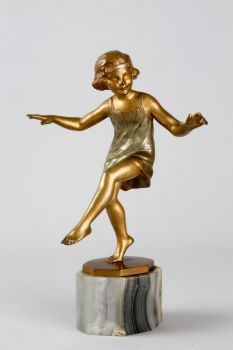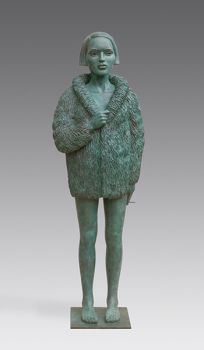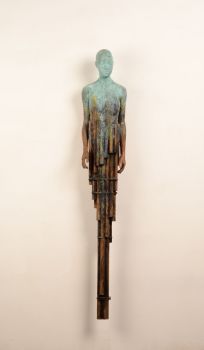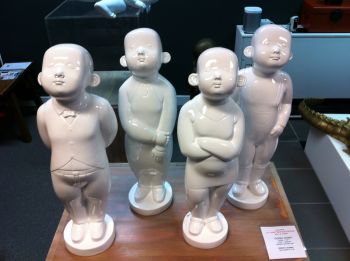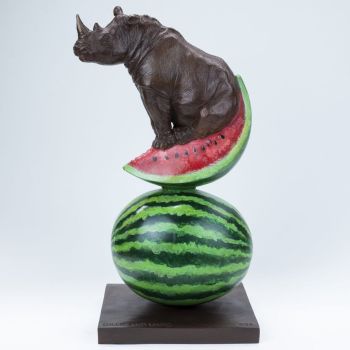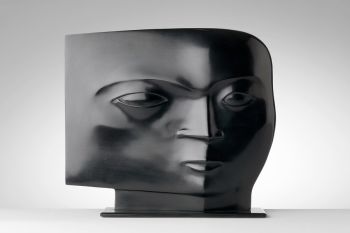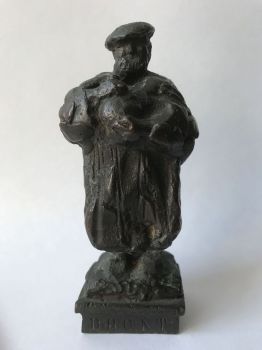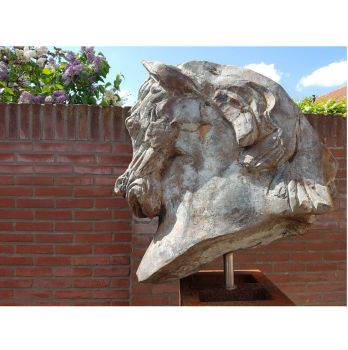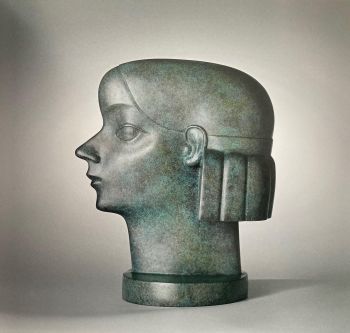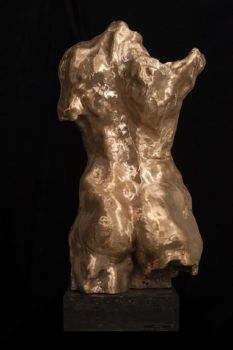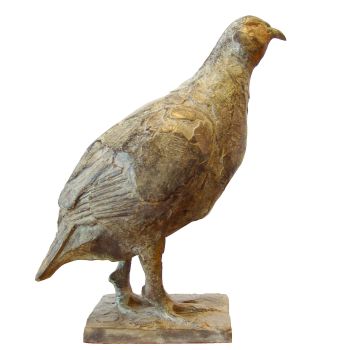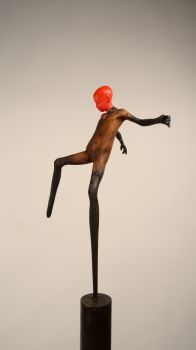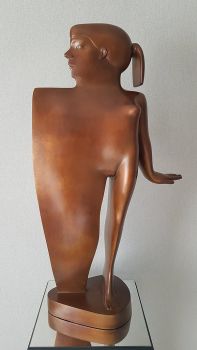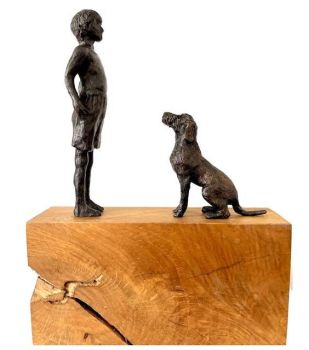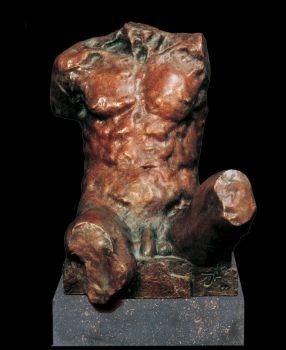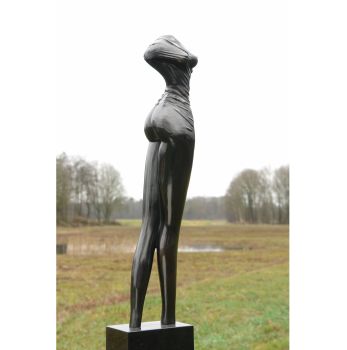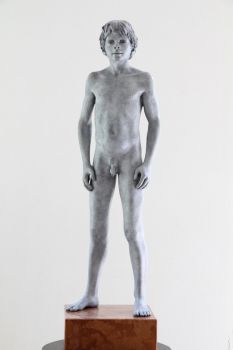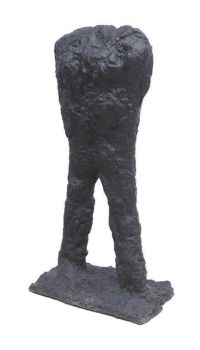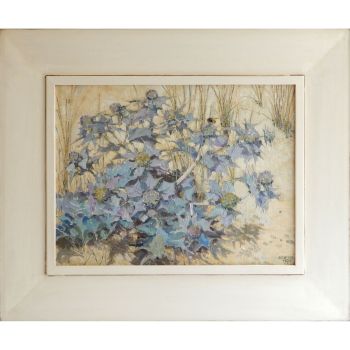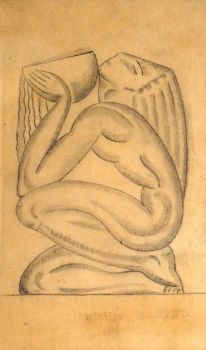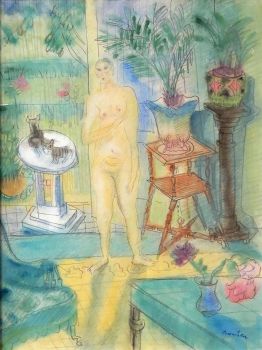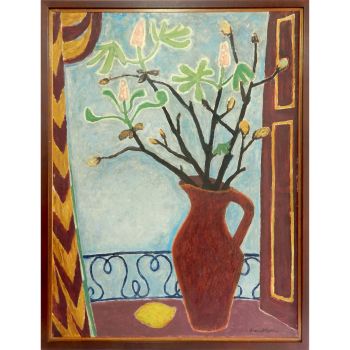Fillette à robe à volant 1948
Léon Indenbaum
BronzeMetal
50 ⨯ 13 ⨯ 11 cm
ConditionExcellent
Price on request
Dille Art
- About the artworkThere's something touching about this girl in her prettiest ruffled dress with a bow in her hair. Indenbaum made this sculpture of plaster in 1948. So far, 7 of the 8 copies have been cast in bronze. This is number 7/8.
It stands on a beautiful marble pedestal and is extensively signed with "Inden, 7/8" and the hallmark of the bronze founder Barthélemy.
----
The family had this sculpture cast in bronze posthumously, because the family believes that their grandfather's sculptures should be seen, they want to give the name Indenbaum the attention and fame it deserves. Léon Indenbaum is known to connoisseurs and is inextricably linked to the Ecole de Paris. Yet they only want to sell a few works, to a very limited extent.
These posthumous sculptures are therefore a first and also the last edition of a maximum of 12. Each sculpture is numbered and officially registered, maximum 8 are numbered 1-8 and four of them are signed EA I to EA IV. (EA stands for Epreuve d'Artiste). This is number 3/8. More examples will not be cast either.
This sculpture also includes an official certificate signed by Léon Indenbaum's grandson. This sculpture with certificate is also registered with ADAGP (Société des authors dans les arts graphiques et plastiques) in Paris.
Biography:
Leon Indenbaum (Tcherikov, now Belarus, 1890 - Opio, 1981), was a Russian/French sculptor who belonged to the group of artists of the École de Paris. His art was innovative, inspired by the classics, but also by African art, the Cubism and Expressionism.
Léon Indenbaum grew up in the shtetl (Eastern European Jewish village) Tcherikov, with his grandfather, who was a bookbinder of art books. After primary school, he was educated as a woodworker. The director of that school thought he was so talented that he arranged for him to attend the Academy of Decorative Arts in Vilnius.
After this training, Indenbaum wanted more and was admitted to the Imperial Academy in Odessa. He went through it for a few years until he crossed a wrong box on a form, he had accidentally signed for 5 years military service in the Imperial Army.
He already had contacts with an artist friend who was in Paris, where so much was happening in the field of art.
Indenbaum managed to escape from Vilnius with the help of an engineer and arrived in Paris in March 1911.
He ended up in 'La Ruche' in Montparnasse, a kind of artists' village.
La Ruche was a circular building, it served as a wine pavilion at the 1900 World's Fair, and was rebuilt by the successful artist Alfred Boucher. Boucher wanted to give poor artists a chance to devote themselves completely to their art. La Ruche was a large round building full of studio apartments, each room had the shape of a slice of pie, in the point a space for a kitchen and storage and above the door was a small loft where you could sleep, often such a studio also had to be shared.
Indenbaum got a studio on the 2nd floor, next to Chagall, who, like himself, had also just arrived from Russia. Indenbaum lived in La Ruche until 1927.
He did have a second studio in Montparnasse for a while.
In total, about 200 artists lived in La Ruche, many of them were from Eastern Europe and many of them were Jewish. Some of them have become world famous with their art, think of Chaïm Soutine, Ossip Zadkine, Jacques Lipschitz, Chana Orloff, Michael Kikoïne, Moïse Kisling , Amadeo Modigliani to name a few.
From 1911 to 1919, Indenbaum studied
sculpture at the Académie La Grande Chaumière, his mentor was the sculptor and painter Antoine Bourdelle, first as a student, later also as his assistant.
In 1912 Indenbaum already exhibited at the Paris Salon d'Artistes Indépendents, he was very poor and his choice of materials was cheap. Jacques Doucet, the great art collector and famous couturier, saw a bust of Indenbaum and summoned him to his home, he wanted the same bust made in a different material, Indenbaum managed to get a piece of onyx.
Doucet was very pleased and asked Indenbaum to make a relief for his round dining room. Indenbaum received 1000 francs per month. Indenbaum had found his patron.
He made one of his most impressive reliefs, entitled 'Musiciens et antelopes' from 1914, made of pink onyx. It was auctioned at Christie's in 2004 for 3.3 million euros.
Besides Jacques Doucet, the couturier René Poiret, the bankers George and Marcel Bénard and the decorator, designer and collector Marcel Coard were regular customers of Léon Indenbaum's sculptures and reliefs.
Léon fell in love with Céline Hénin, she became his muse and his wife, at the end of 1914 they had a daughter, Dinah. Indenbaum was doing well. He had many friends, such as the artists Chaim Soutine, Amadeo Modigliani, with whom he also shared a studio for a period, Tsuguharu Foujita, Chana Orloff, Michael Kikoïne, and Diego Rivera.
Amadeo Modigliani and Diego Rivera both portrayed Indenbaum in 1913 and 1916. Indenbaum himself also portrayed several of his friends. It was the happiest period of his life.
With the stock market crash of 1929, life became much more difficult, people lost their fortunes and could no longer afford works of art. The political situation in France also changed.
The artists from La Ruche and Montparnasse were mostly migrants, at the Paris Salon they were not allowed to exhibit their work among the French artists, an art critic, André Warnod, had given them the nickname 'École de Paris', to show that this innovative avant-garde garde art was also French art. In the 1930s this name was used derogatorily, they were looked down upon, their art was called depraved and because many of them were Jewish, there was also anti-Semitism. They were ignored in the press and in the late 1930s they were no longer allowed to exhibit.
Some artists went abroad. When the war broke out, many had to flee or go into hiding. Indenbaum also had to leave Paris in a hurry. He found a hiding place in a village in the Seine et Marne, where he always got his clay. He was lucky and survived the war, more than 60 percent of the Jewish artists in La Ruche died in the camps.
After the war, Indenbaum settled in Paris again. His studio had been looted and what was left was sometimes destroyed. He lived a very withdrawn life. He had already been separated from Céline before the war, his daughter lived in the south of France. His friends had either not survived the war or had become much too commercial in his view.
He never wanted to commit to a gallery, he felt that he sold his soul, his independence as an artist was at stake, the result was that he was ignored by a large part of the art world. His now famous friends had signed and they were doing well.
Indenbaum wanted nothing more than to work in complete freedom, but in doing so he made it very difficult for him self. He also refused, for example, major commissions from the French state for work on monuments and facades of special buildings.
He was, however, one of the founders of the "Groupe des neuf", a group of nine sculptors who gathered on November 11, 1963 at the statue of Balzac on Avenue Raspail, made by Auguste Rodin.
It was a tribute. They wanted to create a monument to French post-war figurative sculpture at a time when American art was beginning to take over.
The 'Groupe des neuf' consisted of Jean Carton, Paul Cornet, Raymond Corbin, Marcel Damboise, Léon Indembaum, Léopold Kretz, Raymond Martin, Gunnar Nilsson and Jean Osouf. It was a success, there were several exhibitions ofthe group, including in Musée Rodin, a total of 22 sculptors joined the group.
In 1968 Indenbaum received the prestigious Prix de sculpture Georges Wildenstein, from the Institut de France, for his entire oeuvre. In the same year he decided to move to his daughter in Opio. He died at the age of 91. A long life entirely devoted to creating art.
Léon Indenbaum's work can be seen in various museums, including in the United States, Switzerland, Russia, Belarus, Israel and of course in France. Sometimes his work is also auctioned at the major auction houses such as Christies, Sotheby's and MacDougall in London.
Dille Art is the only gallery that represents Léon Indenbaum's sculptures in collaboration with the family of Indenbaum.
Literature and sources:
- Family of Indenbaum
- Jeanine Warnod; "Les artistes de Montparnasse, la Ruche", Éditions Mayer-Van Wilder, Paris 1988. P.42-47, 8, 87,96, 104, 159, 162, 170, 192.
- Nieszawer & Princ; "Histoires des artistes Juifs de l'École de Paris, 1905-1939", Édition Les Étoiles, 2020. P. 190-192, 515 and 516.
- Jeanine Warnod; "l'École de Paris", Édition Musée du Montparnasse, 2012. P. 239, 240 and 243.
- "Chagall, Modigliani, Soutine.... Paris pour école, 1905-1940", Éditions Musée d'Art et d'Histoire du Judaïsme (MAHJ), Paris, 2020 et Réunion des Musée nationaux, Grand Palais, 2020. P. 8, 11, 49, 66, 68, 69, 228, 230, 252.
- G. Annenkoff; "Art Russe Moderne", Éditions Laville, Paris, 1928. P. 50 and 51. - About the artist
Léon Indenbaum (Tcherikov, now Belarus, 1890 - Opio, 1981), was a Russian/French sculptor belonging to the group of artists of the École de Paris. His art was innovative, inspired by the classics, but also by African art, Cubism and Expressionism.
Indenbaum grew up in the shtetl (Eastern European Jewish village) Tcherikov, with his grandfather, who was a bookbinder of art books. After primary school, he trained as a woodworker. The director of that school thought he was so talented that he arranged for him to go to the Academy of Decorative Arts in Vilnius.
After this training, Indenbaum wanted more and was admitted to the Imperial Academy in Odessa. He went through it for a few years until he ticked a wrong box on a form, he had accidentally signed for 5 years military service in the Imperial Army. He already had contacts with an artist friend who was in Paris, where so much was happening in the field of art. Indenbaum managed to escape from Vilnius with the help of an engineer and arrived in Paris in March 1911.
He ended up in 'La Ruche' in Montparnasse, a kind of artists' village. La Ruche was a circular building, it served as a wine pavilion at the 1900 World's Fair, and was rebuilt by the successful artist Alfred Boucher. Boucher wanted to give poor artists a chance to devote themselves completely to their art. La Ruche was a large round building full of studio apartments, each room had the shape of a slice of pie, in the point a space for a kitchen and storage and above the door was a small loft where you could sleep, often such a studio also had to be yet to be shared.
Indenbaum got a studio on the 2nd floor, next to Chagall, who, like himself, had also just arrived from Russia. Indenbaum lived in La Ruche until 1927. He did have a second studio in Montparnasse for a while.
In total, about 200 artists lived in La Ruche, many of them from Eastern Europe and many of them Jewish. Some of them have become world famous with their art, think of Chaïm Soutine, Ossip Zadkine, Jacques Lipschitz, Chana Orloff, Michael Kikoïne, Moïse Kisling , Amadeo Modigliani to name a few.
From 1911 to 1919, Indenbaum studied sculpture at the Académie La Grande Chaumière with the sculptor and painter Antoine Bourdelle, first as a student, later also as his assistant.
In 1912 Indenbaum already exhibited at the Paris Salon d'Artistes Indépendents, he was very poor and his choice of materials was cheap. Jacques Doucet, the great art collector and famous couturier, saw a bust of Indenbaum and summoned him to his home, he wanted the same bust made in a different material, Indenbaum managed to get a piece of onyx. Doucet was very pleased and asked Indenbaum to make a relief for his round dining room. Indenbaum received 1000 francs a month. Indenbaum had found his patron. He made one of his most impressive reliefs, entitled 'Musiciens et antelopes' from 1914, made of pink onyx. It was auctioned at Christie's in 2004 for 3.3 million euros.
Besides Jacques Doucet, the couturier René Poiret, the bankers George and Marcel Bénard and the decorator, designer and collector Marcel Coard were regular customers of Léon Indenbaum's sculptures and reliefs.
Léon fell in love with Céline Hénin, she became his muse and his wife, at the end of 1914 they had a daughter, Dinah. Indenbaum was doing well. He had many friends, such as the artists Chaim Soutine, Amadeo Modigliani, with whom he also shared a studio for a period, Tsuguharu Foujita, Chana Orloff, Michael Kikoïne, and Diego Rivera.
Amadeo Modigliani and Diego Rivera both portrayed Indenbaum in 1913 and 1916. Indenbaum himself also portrayed several of his friends. It was the happiest period of his life.
With the stock market crash of 1929, life became much more difficult, people lost their fortunes and could no longer afford works of art. The political situation in France also changed. The artists from La Ruche and Montparnasse were mostly migrants, at the Paris Salon they were not allowed to hang out among the French artists, an art critic, André Warnod, had given them the nickname 'École de Paris', to show that this innovative avant-garde garde art was also French art. In the 1930s this name was used derogatoryly, they were looked down upon, their art was called depraved and because many of them were Jewish, there was also anti-Semitism. They were ignored in the press and in the late 1930s they were no longer allowed to exhibit. Some artists went abroad. When the war broke out, many had to flee or go into hiding. Indenbaum has also had to leave Paris in a hurry. He found a hiding place in a village in the Seine et Marne, where he always got his clay. He was lucky and survived the war, more than 60 percent of the Jewish artists in La Ruche died in the camps.
After the war, Indenbaum settled in Paris again. His studio had been looted and what was left was sometimes destroyed. He lived a very withdrawn life. He had already been separated from Céline before the war, his daughter lived in the south of France. His friends had either not survived the war or had become much too commercial in his view.
He never wanted to commit to a gallery, he felt that he sold his soul, his independence as an artist was at stake, the result was that he was ignored by a large part of the art world. His now famous friends had signed and they were doing well. Indenbaum wanted nothing more than to work in complete freedom, but in doing so he threw in his own glasses. He also refused, for example, major commissions from the French state for work on monuments and facades of special buildings.
In 1968 Indenbaum received the prestigious Prix de sculpture Georges Wildenstein, from the Institut de France, for his entire body of work. In recent years he lived with his daughter in Opio. He died at the age of 91. A long life entirely devoted to creating art.
Léon Indenbaum's work can be seen in various museums, including in the United States, Switzerland, Russia, Belarus, Israel and of course in France. Sometimes his work is also auctioned at the major auction houses such as Christies, Sotheby's and MacDougall in London.
Are you interested in buying this artwork?
Artwork details
Related artworks
- 1 - 4 / 5
- 1 - 4 / 24
Lambertus Zijl
Portrait of Juliana, queen of the Netherlands (1948-1990)1900 - 1950
Price on requestKunsthandel Pygmalion
Klaas II Mobach
Hanna Mobach, daughter of the sculptor Klaas Mobach, reading1950 - 1970
Price on requestKunsthandel Pygmalion
1 - 4 / 24- 1 - 4 / 24
- 1 - 4 / 24
- 1 - 4 / 12

